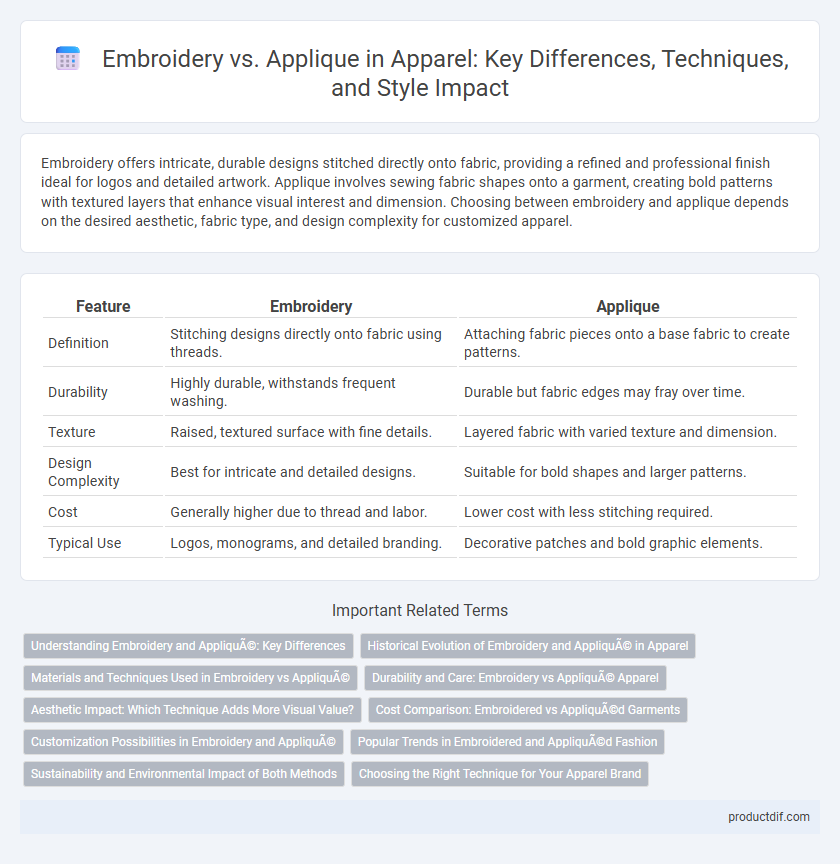Embroidery offers intricate, durable designs stitched directly onto fabric, providing a refined and professional finish ideal for logos and detailed artwork. Applique involves sewing fabric shapes onto a garment, creating bold patterns with textured layers that enhance visual interest and dimension. Choosing between embroidery and applique depends on the desired aesthetic, fabric type, and design complexity for customized apparel.
Table of Comparison
| Feature | Embroidery | Applique |
|---|---|---|
| Definition | Stitching designs directly onto fabric using threads. | Attaching fabric pieces onto a base fabric to create patterns. |
| Durability | Highly durable, withstands frequent washing. | Durable but fabric edges may fray over time. |
| Texture | Raised, textured surface with fine details. | Layered fabric with varied texture and dimension. |
| Design Complexity | Best for intricate and detailed designs. | Suitable for bold shapes and larger patterns. |
| Cost | Generally higher due to thread and labor. | Lower cost with less stitching required. |
| Typical Use | Logos, monograms, and detailed branding. | Decorative patches and bold graphic elements. |
Understanding Embroidery and Appliqué: Key Differences
Embroidery involves stitching thread directly onto fabric to create detailed patterns and textures, offering durability and intricate designs. Applique uses fabric pieces sewn onto a base garment, providing a layered, textured look with contrasting materials. Choosing between embroidery and applique depends on design complexity, garment type, and desired visual effects in apparel customization.
Historical Evolution of Embroidery and Appliqué in Apparel
Embroidery and applique have evolved over centuries as intricate techniques in apparel decoration, with embroidery tracing back to ancient civilizations such as Egypt and China, where hand-stitched patterns symbolized cultural heritage and status. Applique gained prominence during the medieval period, particularly in European fashion, by layering fabric pieces to create elaborate designs on garments and ecclesiastical textiles. Both methods have adapted through industrialization and modern textile technologies, preserving their artistic significance while expanding creative possibilities in contemporary apparel design.
Materials and Techniques Used in Embroidery vs Appliqué
Embroidery utilizes threads such as cotton, silk, or metallic yarns stitched directly onto fabric to create intricate patterns, often with the aid of needles or embroidery machines. Applique involves sewing or gluing fabric pieces like felt, cotton, or denim onto a base cloth, combining different textures and colors for a layered effect. Both techniques require precise craftsmanship, but embroidery emphasizes detailed threadwork while applique focuses on fabric layering and attachment methods.
Durability and Care: Embroidery vs Appliqué Apparel
Embroidery offers superior durability due to its tightly stitched threads that resist fading and wear through multiple washes, making it ideal for long-lasting apparel customization. Applique, while visually bold with fabric pieces sewn onto the garment, may be prone to fraying and requires gentle care to maintain its appearance over time. Proper washing techniques, such as cold water and air drying, enhance the longevity of both embroidery and applique designs on apparel.
Aesthetic Impact: Which Technique Adds More Visual Value?
Embroidery enhances apparel with intricate, precise stitch patterns that create detailed textures and depth, lending a sophisticated and timeless aesthetic appeal. Applique uses fabric layers to form bold, colorful designs that stand out with a three-dimensional effect, offering a more vibrant and eye-catching visual impact. Choosing between embroidery and applique depends on whether the desired look prioritizes fine detail and elegance or prominent, dynamic embellishments.
Cost Comparison: Embroidered vs Appliquéd Garments
Embroidered garments typically incur higher labor costs due to intricate stitching and longer production times, making them more expensive than appliqued pieces. Applique involves attaching fabric patches to the garment, which can reduce material expenses and speed up manufacturing, lowering overall costs. Budget-conscious consumers often choose appliqued apparel for its cost-effectiveness while still offering decorative appeal.
Customization Possibilities in Embroidery and Appliqué
Embroidery offers intricate design customization with detailed stitching techniques that create textured, durable patterns ideal for logos and monograms. Applique provides versatile customization through layering fabric pieces, enabling bold, colorful designs with added dimension and contrast. Both methods allow personalized apparel enhancements, but embroidery excels in fine detail while applique stands out with vibrant fabric accents.
Popular Trends in Embroidered and Appliquéd Fashion
Popular trends in embroidered and appliqued fashion emphasize intricate floral designs and bold geometric patterns that add texture and dimension to apparel. Embroidery often features delicate threadwork using silk or metallic threads, creating exquisite details on denim jackets and dresses, while applique incorporates layered fabric patches or lace, enhancing streetwear and boho-chic styles. These techniques dominate fashion runways and sustainable clothing lines, reflecting a growing demand for handcrafted, personalized garments.
Sustainability and Environmental Impact of Both Methods
Embroidery and applique differ significantly in sustainability and environmental impact, with embroidery typically using less fabric waste due to its needlework-based design that adds thread patterns directly onto the apparel. Applique, involving sewing fabric patches onto a base garment, can generate higher textile waste but allows for fabric recycling by repurposing scraps, contributing to circular fashion principles. Both methods offer eco-friendly potentials when utilizing organic threads and recycled fabrics, but embroidery often has a smaller carbon footprint and water usage, making it a more sustainable choice in apparel decoration.
Choosing the Right Technique for Your Apparel Brand
Embroidery provides a durable, high-quality finish ideal for logos and intricate designs, enhancing brand recognition through detailed stitching. Applique adds texture and dimension by layering fabric pieces, perfect for bold, eye-catching apparel that demands a unique look. Choosing between embroidery and applique depends on the desired aesthetic, garment type, and production budget, ensuring the technique aligns with your brand's identity and target market.
Embroidery vs Appliqué Infographic

 productdif.com
productdif.com